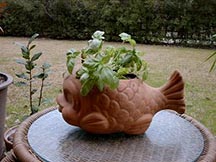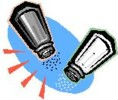Make the most of culinary herbs and spices.
Other articles you might enjoy:
1. The Simple, Essential Herb Garden
4. Look What I Made: An Herb Drying Rack
An Herb Gardener's Diary - Part Four
by Sandra Bowens
Here's one that's full of our favorite recipes because we wrote the book! It is also full of information, helpful hints and ideas for using herbs and spices in your kitchen.
The winter herb garden is well under way. My little collection of plants has become a true kitchen garden. I have learned a great deal about growing herbs over the past nine months. I am happy with my decision to garden in containers rather than the traditional "in the ground" method. This has given me the flexibility to rearrange on a whim, isolate plants that are in trouble and protect delicate foliage from wicked weather.
Update
Few of the herbs mentioned in previous "diary" articles remain. I wish I could say this is because they were annuals (plants that live out their life in a single season) but that was only the case with the basil. I finally gave up on the ill-fated seedlings that tried so hard.
The bay laurel tree (see this plant in the background in the photo above) is over a foot high now and shows excellent growth. The chives seem to have gone dormant with the cool weather but the Bountiful Containers gardening book suggests this is normal. The lemon-thyme and oregano became somewhat leggy and brownish while I was away on an extended trip but show new vigor lately. The rosemary and parsley plants are thriving in these cool temperatures.
I have come to realize I am too impatient of a person for seeds. Planting seeds is an interesting exersize in the growing process but it takes a long time before you can actually harvest herbs from the baby plants. Seeds appear to be the only way to go for certain plants in my area. I looked and looked for chervil and savory plants before I finally decided to go with starting them from seed.
Cost Effectiveness
The true beauty of herb gardening came to me last week when I needed more oregano than my little plant could provide. Two-thirds of an ounce of fresh sprigs cost $2. The following day, during a visit to a garden center, I bought a gorgeous dill plant for $1.50. Having plants allows us to snip whenever we wish while the supply is continually replaced.
I have come to appreciate terracotta pots for the same cost effective reasons. Compare the basic six-inch clay pot for a dollar to a hand painted ceramic vessel for $20. Think how many more plants you could buy with the savings! There is also a certain genuineness to that deep green plant in the familiar burnt orange container.
You can find plenty of choices in terracotta pots too. Different shapes, sizes and designs help to keep with the theme while adding variety.
It does seem to be true that you have to water more frequently when using clay pots rather than plastic or ceramic. Again, that savings is worth a bit more work if you ask me.
Seasonal Challenges
Unless they live in a steady temperate climate, all gardeners struggle against the weather at some time of the year. For most it is probably harsh winter weather but in Louisiana, it's the heat of summer.
While we do get an occasional freeze during the winter months, it is the blistering heat of long July and August days that prevent us from growing crops like lettuce and spinach. That's why I am taking full advantage of the winter to grow containers of those leafy vegetables as well as arugula and chervil.
Arugula is one of my favorite plants. It is easy to grow from seed and the leaves are delightful in salads and on sandwiches. As the seeds began to sprout and grow, I noticed two seedlings that were unlike the others. These two rogue plants are now twice the size of the arugula plants. I have no idea what they are!
The chervil seeds were only sown a few days ago. They are the type that need light for germination so you just sprinkle them onto the top of damp soil and keep them moist. The challenge with this kind, and all seedlings really, is to give them a steady supply of water without drowning or uprooting. I use a spray bottle set to the finest mist and spray them everyday. Chervil is said to be good for growing indoors because it does not like a lot of sun.
Changing patterns in the sunshine have caused me to rearrange many of the pots. I hadn't taken this into consideration until I put all my pots of freshly sown seeds on the front patio where ample sun shines in the summer. After sprouting they began to grow at an angle, indicating they were not receiving enough light. I moved the containers to the back where they get plenty of morning sun and they began to grow much better.
Experimental
So many empty pots from annuals inspired me to begin an experiment when I went to plant a cold weather crop of Thai Silk poppies. I placed one pot of seeds in an area where it would have afternoon sun and another where it receives morning sun. Those plants that sprouted in the afternoon sun appear stronger and greener, although the pot must be turned every couple of days because they lean toward the sun. The morning sun sprouts stand straight but seem more fragile. Poppy sprouts are pretty, lacey little things. I hope they will grow into the stunning flowers promised by the catalog.
My citronella scented geranium grew leggy over the summer. The only way to combat this, according to the Bountiful Container book, is to take cuttings. After rooting in water I was supposed to be able to plant them back into soil. Although the cuttings showed minor foliage growth at the tips, they never did grow roots. I went ahead and pushed them into a pot of soil. I will keep an eye on those sprigs as well as the main plant that I cut them from for new growth.
My balloon flower plant offered enchanting blue flowers during the summer but went downhill as the cool weather set in. The rootball is barely visible on the surface of the dirt and looks viable for another season. It is a perennial so I am treating it with care in hopes that it will send up new foliage again soon.
I have learned that many perennials, and also bulbs, need a period of dormancy to generate growth for another year.
Edible Flowers
Reading the Herbfarm Cookbook, various gardening/cooking articles and questions from website readers has given me a keen interest in edible flowers. I think I have as many questions as I do ideas about using them.
I know you must be careful about eating flowers that have been treated with chemical fertilizers--even those that are mixed into the soil. I hadn't considered this when I ate one of my pansies. I was only thinking of insecticides that are sprayed onto the foliage not the slow-release granular fertilizer I had mixed into the soil before I transplanted them.
Same problem for the day lilies I was thinking I would be able to eat this summer. The flower beds that they grow in have all been fertilized or sprayed with insecticides at one time or another in the last year.
This is food for thought in favor of organic gardening, isn't it?
Thanks to several questions from website readers recently, I have learned that you can pickle the buds of nasturtiums. The result is similar to a caper. I can't resist trying this so I have ordered seeds. Nasturtiums are beautiful flowers that are said to have a robust flavor as well. You can even eat the leaves. I will be sure to go completely organic with this container.
Tips
1) Each plant has special needs so be sure to follow instructions on seed packets.
2) Do your homework to find plants that are hardy enough to withstand your climate or that are flexible enough to grow in a sunny windowsill if you can't have a winter garden.
3) Take note of where the sun shines during each part of the year to aid in planning.
4) Reading about gardening helps you become more knowledgeable about the plants you want to grow and is a good substitute for the real thing when the weather keeps you indoors.
5) Never eat flowers unless you are certain they are safe to ingest and that they were grown without chemicals. Rest assured that all herb flowers are edible.
Spring Fever
Looking ahead to warmer weather sends visions of green, green growth dancing through my head. Why not plant a few herb pots for yourself this spring? You will be glad you did!

Learn herb gardening from the ground up, literally, with the help of a knowledgeable teacher and gardener.

Follow along as the US learns to love real food. It's not just what we eat today but why. See aPinchOf.com's review of this book.
Check out all of the other titles too in this tiny bargain-priced series of yummy and quick herbal recipes.
A luscious book from the Herbfarm kitchen-nursery filled with unusual ideas for using fresh herbs. See aPinchOf.com's review of this book.
This site's readers love this book. Filled with glorious photographs, it will give you new ideas for a lovely flower garden that tastes good too.







